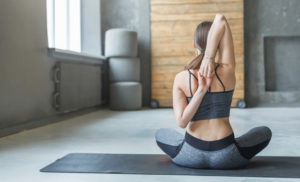One of my most favourite tools from my expanded yoga tool-kit is yoga self-massage. It is a regular feature in my classes and workshops and a constant in my personal practice. In this post I want to lay out the reasons why I now include it in my yoga practice and teaching, how you can do it, and when during your practice and your day you should do it.

Why Yoga Self-Massage
Yoga self-massage for me means primarily rolling with the use of yoga tune-up therapy balls or balls of similar size and consistency, as taught to me by Jill Miller (please see her work for in-depth explanation of all these points). Tennis balls or squash balls can be a temporary substitute, but they are not as effective. However, even self-massage in selected regions with one’s own hands can be helpful. Here is a non-exhaustive list of why you should include these techniques:
Body Awareness
Self-massage, simply put, will help you feel regions of your body that perhaps you are not used to feeling. Combined with a yoga and movement practice that highlights these region, self-massage can lead to an improved sense of proprioception, or awareness of your body in space. For example, if you want to practice with outer hip strength in balancing postures, a good way to teach yourself or your students about how to use this region is to help them feel where it is first through simple rolling.
Mobility
Self-massage prior to stretching can help improve flexibility and strength. According to Jill Miller’s book The Roll Model Method, therapy ball rolling also helps hydrate your tissues and breaks apart adhesions. All this leads to a more mobile body able to move with more ease. Sticking with our hip example, you may also see greater success in activating the strength and mobility of the outer hip in your yoga practice if you roll it first.

Pain Reduction
Pain is often mysterious, but what can help us with pain in our bodies is improving our sense of body awareness, or, more simply, learn to feel the reality of what’s going on within our bodies. Citing the work of Robert Schleip and Amanda Baker, Miller states “increasing fascial proprioception diminishes your perception of pain.” There may also be a pain reducing effect from the motion and pressure of a massage ball itself.
Stress Reduction
The web of fascia that encompasses every muscle and organ is intimately connected to our nervous system. Citing the work of fascia expert Robert Schleip, Miller explains that by stimulating specifically Ruffini nerve endings you can calm your nervous system.
Practical Self-Care
At a fundamental level, I believe that including self-massage in your practice teaches you what it means to care for yourself. Self-compassion and self-care are big concepts and may take a lifetime to fully embrace, but you have to start somewhere. I often joke that if you want to begin to love yourself, why don’t you start with your feet?

How to Yoga Self-Massage
If you are using a soft tool as suggested or your own hands, there is really nothing to be worried or afraid about doing wrong. You can of course get very specific in targeting individual muscles and applying specialised techniques, but until you get that training, you can definitely keep it simple. Remember that this is not about pain or breaking up something bad in your body. This should all be done with an attitude of kindness, care, and love.
- Choose a region to explore. Start small.
- Place ball or hands on or under this region (you can work at the floor or against a wall).
- Breathe with sustained pressure until you are ‘invited’ in to explore more deeply.
- Experiment with up-down, side-to-side, and circular movements.
- After completion, check-in to see how you feel and if anything feels different or more awake.
Here are a few of my practices that include self-massage:
- Yoga Foot Ball
- Head, Neck, Face, and Jaw Massage
- From the Shoulders on Up
- Restorative Flow: Feet, IT Band, and Twists
- 30 for Self-Care
When to Yoga Self-Massage
There are no hard and fast rules about when to include yoga self-massage in your practice or throughout your day. Whenever it is you practice you might find that rolling helps you prepare regions to actively work or to be present in your awareness as you move. There is also value in rolling at the end of practice to help cool down hard worked regions and to calm yourself in to rest. Keeping that in mind, if you are rolling outside of a full yoga practice, you can use its stress reducing capacity to your benefit and use it as part of your evening wind-down or whenever you need to walk yourself back from the edge. As a general rule, you might find that the higher up the body you massage, the more stress-reducing capacity it will have. So try your shoulder, neck, and head massage closer to bedtime as an evening treat.
Try this tool as part of your yoga practice and let me know what you discover!
The post Yoga Self-Massage – Why, How, and When appeared first on Adam Hocke Yoga.
Details of why self-massage is one of the favourite tools in my expanded yoga toolkit
The post Yoga Self-Massage – Why, How, and When appeared first on Adam Hocke Yoga. Read More
Read More








